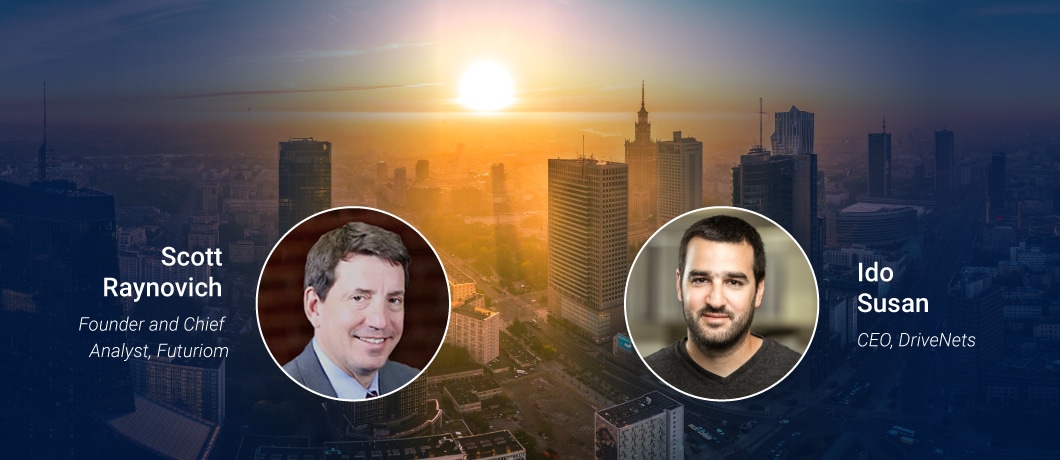After selling Intucell and then dabbling in satellite technology, Susan decided to go back to his roots in networking. In recent years, with the popularity of the cloud exploding, this gave enterprises the capability to build and access applications in a cloud-native fashion. But the service provider industry has struggled to keep up with the pace of the cloud and likewise put their services in cloud-native environments. DriveNets aims to help service providers do this by offering the Network Cloud – a cloud-based routing infrastructure that can cost-effectively grow and scale on demand. It applies a hyperscale cloud approach to service provider networks. The company’s software runs on standard networking white boxes that are sold directly by their manufacturers.
DriveNets raised one of the largest Series A financing rounds in Israel to date which amounted to $117 million, creating significant buzz around the industry, with the inclusion of some notable and well-known investors like John Thompson of Microsoft and Steve Luczo, chairman of the board of Seagate and its former CEO. Futuriom Principal analyst, R. Scott Raynovich recently caught up with Susan to talk about his career and the evolution of the Telco Cloud.
To Learn More, Download the White Paper:
Introducing DriveNets Network CloudHow things started
Futuriom: How did your first startup, Intucell, happen? Susan: We started Intucell with the idea of Location Based Services (LBS). The idea was that when you’re going to the mall, we detected that you entered the mall and pushed you marketing. The technology worked but we figured out that consumers didn’t want it. So, we used the technology to solve an engineering problem with the network – it was unbalanced and dropped calls. This is how we created our first product, the self-optimized network (SON)— we detected the issue and solved it and we scanned the network to verify that the problem was solved. This is how we started Intucell. Futuriom: And you sold that to Cisco for a lot of money. Susan: We sold it for $475M to Cisco. I was 27 years old and I joined Cisco as a young executive. I will always say that Cisco is like family. I worked with amazing people. I got the best education… better than college… which is what I said to my father. When you join a company generating $1B per week, it’s the best school. Futuriom: When did you leave Cisco? Susan: 2015.Founding DriveNets
Futuriom: So you never took a vacation? You were a young and successful you could have gotten a boat and gone around the world. Susan: Not really. I took two months of vacation and then my wife told me I need to get out of the house and find a new job otherwise we would have a problem. I had an idea, looking at what happened in the compute world. There was a cycle moving to commodity hardware, x86. And then there was another generation moving to virtualization – with VMware and KVM and stuff like that. And then there was another generation moving to what we are familiar with today, the cloud. I looked at the storage world that moved from IBM and EMC to x86 and software-defined storage and [compared with] networking world, nothing happened in networking. Everything was still based on chassis with line cards with proprietary ASICs, proprietary NPUs, and proprietary software. I said, okay this is a good area to go to disrupt, because the problem is that the traffic is growing and will continue to grow because we will consume more and more bandwidth, if it’s content, Webex or Zoom, or consuming more from the cloud. The Average Revenue per User (ARPU) [for the service providers] is going down. You must somehow provide more bandwidth with a better cost per bit. The only way to do that is with software. I decided this was going to be my next project, so I founded DriveNets with Hillel, my partner [Hillel Kobrinsky is the Co-Founder and Chief Strategy Officer of DriveNets). When we started out about four years ago, all the incumbents – Juniper, Cisco, Arista – said to our customers, “those guys are really smart, but networking is not like compute and storage, you won’t be able to convert it to software.” Today, the solution is up and running. We are running in different stages with 20 customers – most of them Tier-1 service providers and hyperscalers. We generate tens of millions of dollars in revenue, but there is lots of work in front of us. No doubt that the technology is working. All the incumbents are going to disaggregation. They will not be able to compete with software-based solutions with the hardware technology they have today. So, I want DriveNets to do in the networking space what VMware did for compute and storage. Futuriom: So how many employees do you have now? Susan: We just passed 300 employees.Will startups unseat incumbents
Futuriom: I have been following software-defined networks for a while. You had the first generation with Nicira, than other companies like Cumulus and Big Switch. You seem to be part of a third generation including companies like Alkira and Arrcus. Is this market going to support startups? The startups have had trouble displacing the incumbents. Can this generation do it? Susan: The answer is yes. The market is large enough. The routing market for service provider is around $12 billion for core, aggregation and metro. If you add the hyperscale, and edge compute, they are going to spend more in routing at the edge. Alkira has some smart guys who founded the SD-WAN company Viptela. That’s a different market from us. They are in the enterprise space. Arrcus is competing with us. We welcome more competition. If we were alone competing with Cisco and Juniper, this market would not be disrupted. You need several vendors to disrupt a big market like networking. Look at software-defined storage – you had 6-8 companies that disrupted that market and that is what helped create a market with new, open technology. I think we were the pioneers to disrupt high-scale networking, and hope and expect that other disruptors will follow.Telecom and network virtualization
Futuriom: Let’s dive into telecom. We’ve followed Network Functions Virtualization (NFV) in telecom and it’s had many twists and turns. You described it well, they need to reduce their costs. Their operations are complicated and expensive. How much progress have they made and how will they be successful? Susan: It’s a good question, it really depends on the customer. Right now we are working with 20 or so customers in different stages. The U.S. market is leading this activity by 12-18 months. Overall, I think that NFV failed. NFV is designed for compute and not for networking. We started to develop our solution based on x86 servers and SmartNICs and were able to get from one server 400 Gigabit/sec of routing capability. But the hardware would have cost $20,000, which is not cost-effective with the best hardware from Intel. We did all the tricks in the book to get the best performance, but the main challenge was the cost per bit, it was very high. And then we figured out that taking compute and storage for cloud and using it to run networking applications doesn’t make sense. It’s not designed for networking. We decided to start from scratch. We knew that we need a very fast data paths, so we took Broadcom’s chipset. We needed to detach the data path from the control. Because we will need to run multi-controllers sharing the same data path to get better utilization. We were able to get 10X better pricing. And now we improved it some more. If you think of what happened with [virtual machines], you were able to get better utilization running multiple services on the CPU. This is exactly what we are doing in the networking space. Futuriom: Very interesting. Where did all the cost savings come from? Susan: The first savings is if you buy the hardware directly from an ODM, it’s open so you are not locked to one vendor and have more pricing flexibility. You select the hardware and you run the software that you want. Just like compute – you pick HP or Dell, and then you pick the software. SPs are not able to do it with the networks. If they put in the Cisco chassis, they are locked into Cisco. They aren’t able to buy linecards from Juniper or software somewhere else. Second, you have the same building blocks for every network. You don’t need a different flavor of hardware for different scales or use cases. You have two pizza boxes to build any size network. Each white box is four terabits. If I need 200 terabits, I install 50 white boxes in a cluster, and the software is like a big cloud. Basically, you simplify the network so you don’t need multivendor and multi-flavor of hardware and you are not locked into a vendor. They are simple white boxes and you select the software you run on top of them. This is where you get the savings. Third, you get better utilization because you get multiple services sharing the same hardware infrastructure, like in the virtualization of the compute space. Same concept. And finally, the saving from software based. You don’t need to send people to the field, you automate the process. So, you buy hardware from ODM and the core system is installed automatically. Everything should be plug and play.Outlook for DriveNets
Futuriom: You might have the best technology, but you have to convince them to buy from a startup rather than Cisco and Juniper. Susan: You need to get the trust of the people at the Service Providers. It worked with them when I was at Cisco. The service providers understand that in order to survive and have good margins, they must do something different. They must convert the hardware to software. I’m not aware of any Tier-1 service provider that don’t have a program to convert from hardware to software. They called it VNF, NFV, CNF – all this relates to how to simplify the network, use the software to reduce the cost and most importantly grow the capacity to meet demand and reduce cost. VMware was small when it did it in compute and storage, and then it grew. Service providers have seen it and some of them – the bold and the visionary will adopt technology from smaller vendors. Then the rest will come. Futuriom: What do you expect in the coming year? We expect to see more change in 5G and in the Telco Edge with compute and networking coming closer together. I also expect that software-based solutions, cloud architectures and white boxes will play a key role in the market, with DriveNets as a strong participant and technology leader.Download White Paper
Introducing DriveNets Network Cloud




